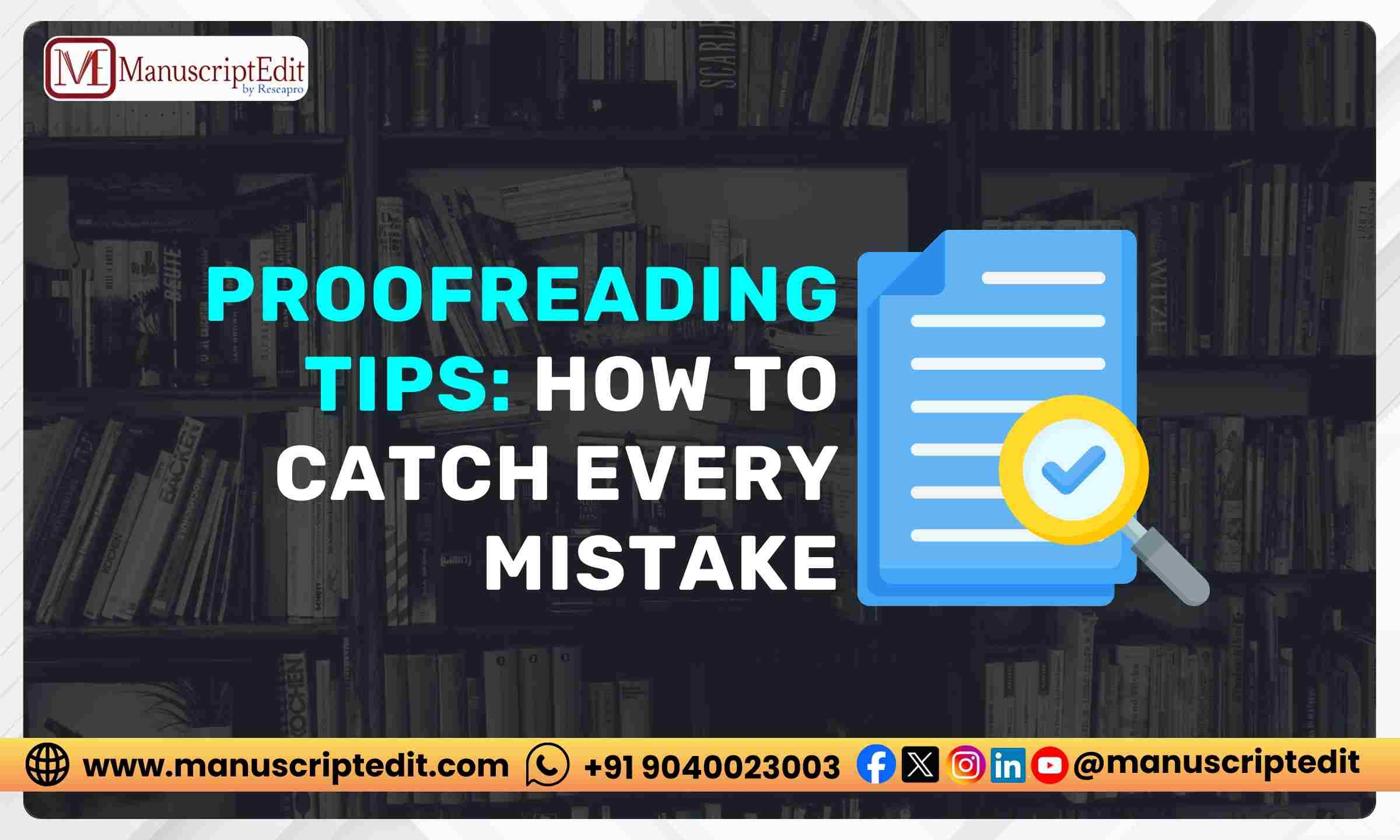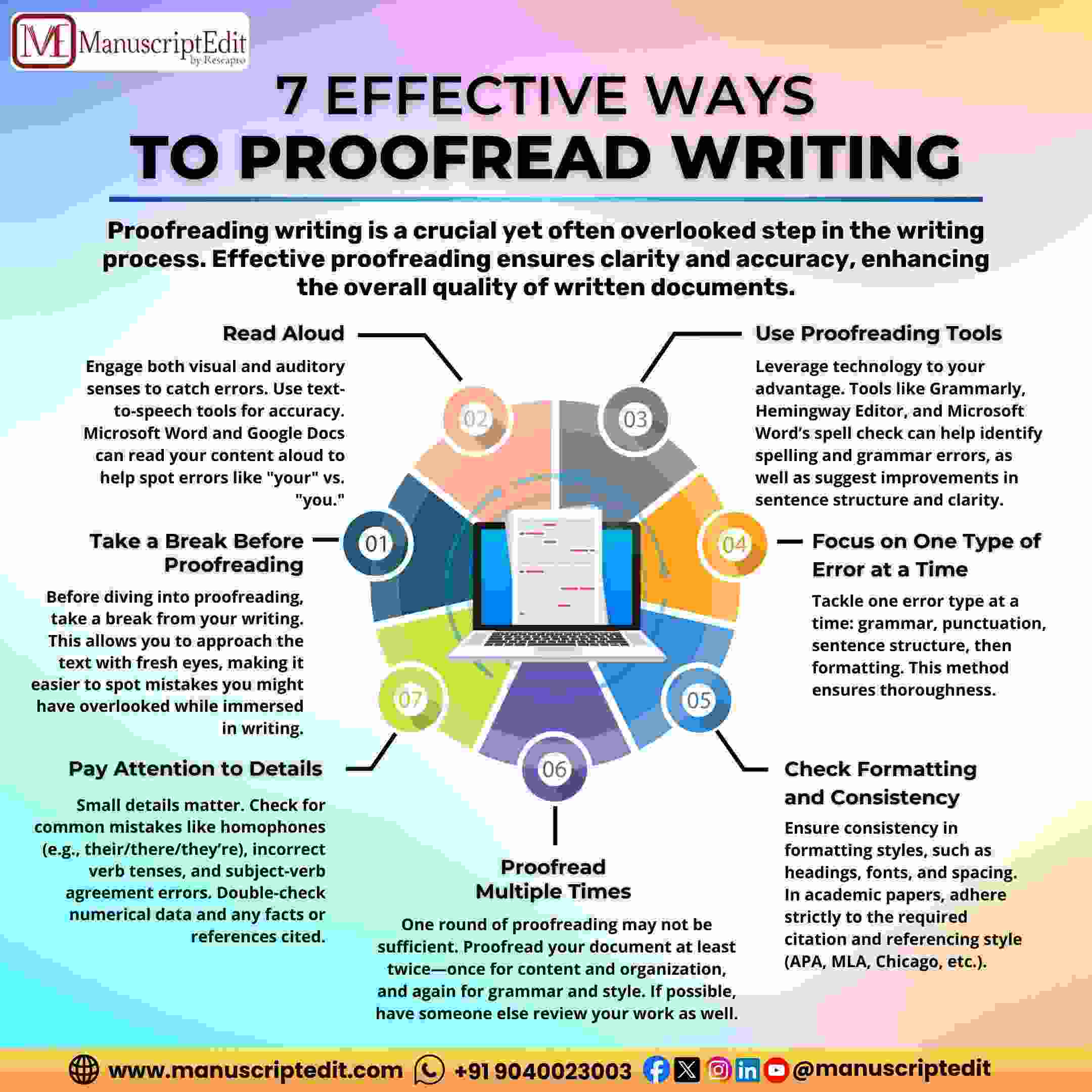|
Getting your Trinity Audio player ready...
|
 Effective proofreading is more than just scanning through a document; it requires a systematic approach to ensure every error is caught before final submission. Whether you’re polishing a research paper, a professional report, or even a social media post, mastering proofreading techniques can significantly enhance the quality of your work. Here are essential tips to help you become better at editing and proofreading:
Effective proofreading is more than just scanning through a document; it requires a systematic approach to ensure every error is caught before final submission. Whether you’re polishing a research paper, a professional report, or even a social media post, mastering proofreading techniques can significantly enhance the quality of your work. Here are essential tips to help you become better at editing and proofreading:
1.Take a Break Before Proofreading
Before diving into proofreading, take a break from your writing. This allows you to approach the text with fresh eyes, making it easier to spot mistakes you might have overlooked while immersed in writing.
2.Read Aloud
Reading your text aloud engages both visual and auditory senses, making it easier to identify grammatical errors, awkward phrasing, and missing words. This technique helps in catching mistakes that might not be obvious when reading silently. Consider using text-to-speech tools after completing your draft. You can read each line aloud to detect and correct errors. However, did you know Microsoft Word and Google Docs can also read your content aloud? How does this feature help? Sometimes, errors like mistyping “your” as “you” or “our” as “out” can go unnoticed by standard spellcheckers because these are valid words. Listening to your content being read aloud helps you easily spot and correct such errors.
3.Use Proofreading Tools
Leverage technology to your advantage. Tools like Grammarly, Hemingway Editor, and Microsoft Word’s spell check can help identify spelling and grammar errors, as well as suggest improvements in sentence structure and clarity.
4.Focus on One Type of Error at a Time
To avoid feeling overwhelmed, focus on specific types of errors during each proofreading session. Start with grammar, then move on to punctuation, sentence structure, and finally, formatting. This methodical approach ensures thoroughness.
5.Check Formatting and Consistency
Ensure consistency in formatting styles, such as headings, fonts, and spacing. In academic papers, adhere strictly to the required citation and referencing style (APA, MLA, Chicago, etc.).
6.Proofread Multiple Times
One round of proofreading may not be sufficient. Proofread your document at least twice—once for content and organization, and again for grammar and style. If possible, have someone else review your work as well.
7.Pay Attention to Details
Small details matter. Check for common mistakes like homophones (e.g., their/there/they’re), incorrect verb tenses, and subject-verb agreement errors. Double-check numerical data and any facts or references cited.
8.Review Spelling Consistently
Pay special attention to commonly misspelled words and typographical errors. Some errors may slip through automated tools, so manually review each word, especially names, technical terms, and industry-specific jargon.
9.Use a Checklist
Create a personalized proofreading checklist that includes your most frequent errors. Refer to this checklist each time you proofread to ensure comprehensive error detection and correction.
10.Seek Feedback
After proofreading your document, seek feedback from peers, mentors, or professional editors. Fresh perspectives can uncover overlooked errors and provide valuable suggestions for improvement.

Consider this why would someone do manual review instead of automated review?
Manual review techniques are essential for several reasons, especially when it comes to proofreading content like the one outlined above:
- Enhanced Accuracy: Manual review allows for a deeper, more nuanced examination of the text compared to automated tools, which may miss context-specific errors or subtle mistakes.
- Improved Understanding: Reading aloud and reviewing manually helps to improve comprehension of the content, ensuring clarity and coherence in writing.
- Greater Control: Manual techniques give the reviewer more control over the proofreading process, allowing them to focus on specific types of errors and ensure consistency throughout the document.
- Adaptability: Unlike automated tools, which may not cater to all writing styles or formats, manual review techniques can be tailored to suit the specific requirements of different types of content, such as academic papers or creative writing.
- Development of Skills: Practicing manual proofreading techniques enhances one’s editing skills over time, fostering a critical eye for detail and improving overall writing proficiency.
- Comprehensive Review: Manual review ensures thorough scrutiny of all aspects of the text, including grammar, punctuation, formatting, and coherence, which collectively contribute to the quality and professionalism of the final product.
In essence, while automated tools offer convenience and speed, manual review techniques are indispensable for achieving meticulousness, clarity, and precision in written communication.
Mastering Manual Proofreading: Techniques for Error-Free Writing
How to Do Proofreading Without Any Tools
Proofreading without relying on automated tools requires a disciplined approach and keen attention to detail. While software can streamline the process, mastering manual proofreading techniques enhances your ability to catch errors effectively. Here’s a comprehensive guide on how to proofread without any tools:
- Take a Break and Clear Your Mind
Before starting the proofreading process, take a break from the text. This break allows you to approach the document with fresh eyes and a clear mind, making it easier to spot errors that might have been overlooked during the writing phase.
- Read Backwards
To focus solely on spelling errors and typos, read the text backwards—starting from the last word and working your way to the beginning. This unconventional method disrupts the flow of the text, allowing you to concentrate on individual words without getting caught up in the narrative.
- Use a Printed Copy
Printing out your document provides a different perspective compared to reading on screen. Marking up errors and making notes directly on the paper helps visualize corrections and improves overall accuracy. This tactile approach can uncover errors that might be missed on a digital display.
- Focus on One Type of Error at a Time
To maintain concentration and thoroughness, concentrate on specific types of errors during each proofreading session. Start by checking for grammar and punctuation errors, then move on to sentence structure, clarity, and overall coherence. This systematic approach ensures comprehensive error detection.
- Check for Consistency and Formatting
Ensure consistency in formatting, such as headings, fonts, and spacing throughout the document. Pay attention to alignment, indentation, and the use of lists or bullet points. In academic or professional writing, adhere strictly to required citation and referencing styles (APA, MLA, Chicago, etc.).
- Verify Numerical Data and References
Double-check all numerical data, calculations, and statistical information presented in your document. Verify that references, citations, and sources are accurately cited according to the required format. Errors in these areas can undermine the credibility of your work.
- Review for Clarity and Coherence
Evaluate the overall clarity and coherence of your writing. Ensure that ideas flow logically and transitions between paragraphs are smooth. Check for repetition of ideas or information and eliminate unnecessary words or phrases that do not contribute to the clarity of your message.
- Pay Attention to Details
Be meticulous in your review. Watch out for commonly confused words (e.g., affect/effect, their/there/they’re), verb tense inconsistencies, and subject-verb agreement errors. Scrutinize names, technical terms, and industry-specific jargon for accuracy and correct usage.
Take Advantage of a Checklist
Create a personalized proofreading checklist that includes common errors you tend to make. Refer to this checklist systematically to ensure thorough error detection and correction. A checklist helps maintain focus and prevents overlooking critical aspects of proofreading.
Mastering manual proofreading not only improves the quality of your writing but also strengthens your editing skills overall. Practice regularly to refine your technique and develop a keen eye for detail, ensuring your documents are polished and error-free before submission.
For more insights on enhancing your proofreading skills, visit [ManuscriptEdit](https://www.manuscriptedit.com) today.
Mastering the art of proofreading takes practice and attention to detail. By implementing these proven techniques—taking breaks, using tools effectively, and focusing on specific errors—you can significantly improve the quality and clarity of your writing. Remember, thorough proofreading not only enhances your professionalism but also ensures your message is conveyed accurately and effectively.



